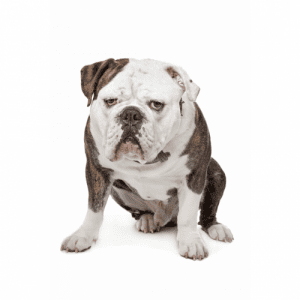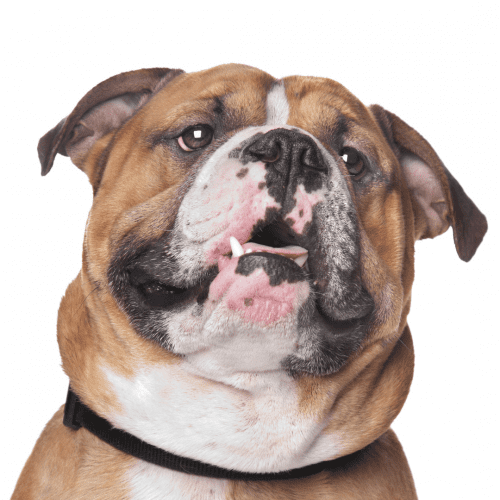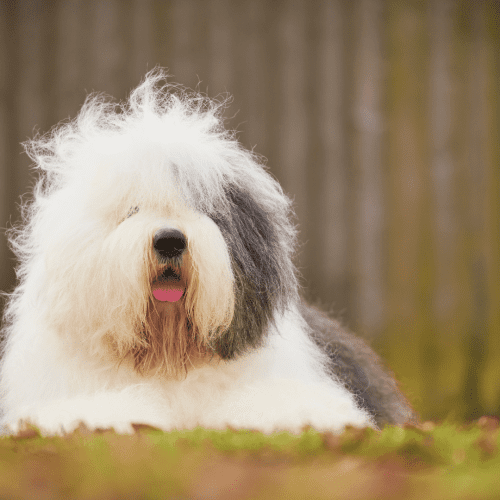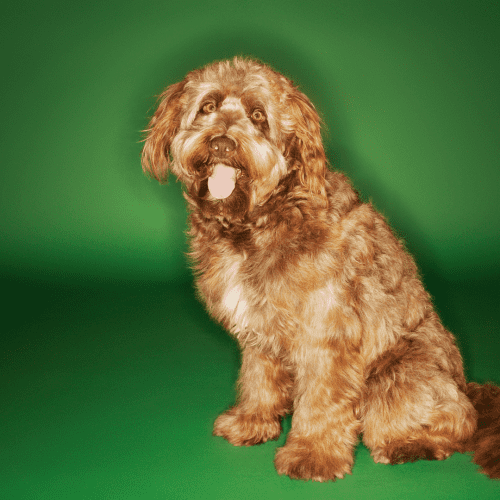Dog breeds starting with the letter “O”.
The Old English Bulldog (aka Olde English Bulldogge) Dog Breed

What Is The History Of The Old English Bulldog (aka Olde English Bulldogge) Dog Breed?
The Old English Bulldog (aka Olde English Bulldogge) is a dog breed that originated in England. The breed was created by crossing the English Bulldog with other breeds, such as the Mastiff, to create a more athletic and healthy dog. The Old English Bulldog was used for bull-baiting and dog fighting, but these activities were outlawed in 1835. The breed then became less popular and nearly extinct. However, in 1971, an American breeder named David Leavitt set out to revive the breed. He succeeded in creating a dog that resembled the Old English Bulldog of days past but was healthier and had a better temperament. Today, the Old English Bulldog is once again a popular breed and is cherished by dog lovers worldwide.
What Does An Old English Bulldog (aka Olde English Bulldogge) Look Like?
Old English Bulldogs have a short, thick coat that comes in various colors such as White, Fawn, Piebald, Brindle & White, Fawn & White, Red & White, Red Brindle, Red. The coat is relatively easy to groom and only requires occasional brushing to remove loose hair. These dogs are not heavy shedders but shed more during the spring and fall seasons. Old English Bulldogs have a wrinkled face with short muzzles. Their ears are small and droop down close to their head. They have wide chests and strong legs. Their tail is usually short and stubby.
How Big Is An Adult Old English Bulldog (aka Olde English Bulldogge) Dog?
The average Old English Bulldog (aka Olde English Bulldogge) is about 12 to 16 inches tall. Males typically weigh between 50 and 55 pounds, while females usually weigh between 40 and 50 pounds. However, there is a great deal of variation in size within the breed, so that some individuals may be larger or smaller than average. Generally speaking, Old English Bulldogs (aka Old English Bulldogges) are stocky dogs with short legs and thick bodies. They have broad chests and wide heads, and their tails are often docked to a shorter length. Overall, they are muscular dogs with a lot of strength and power.
Are There Other Dog Breeds Related To The Old English Bulldog (aka Olde English Bulldogge) Dog?
Yes, there are several other dog breeds that are related to the Old English Bulldog (Olde English Bulldogge) or share similar traits. These breeds are often grouped under the “bulldog” category due to their historical connections, physical characteristics, or similar roles. Here are a few examples:
- English Bulldog: The direct ancestor of the Olde English Bulldogge, the modern English Bulldog, shares some characteristics with its older counterpart. However, it has been selectively bred for a stockier build, shorter muzzle, and distinctive appearance. Unfortunately, these traits have also led to health issues in some individuals.
- American Bulldog: The American Bulldog is a breed that shares some heritage with the Old English Bulldog. It’s known for its strength, agility, and loyalty. American Bulldogs are often used as working dogs, and they can have a similar appearance to the Olde English Bulldogge.
- Boxer: The Boxer is another breed that has some similarities to the Old English Bulldog. They are muscular, energetic dogs known for their playful and affectionate nature. Boxers were developed in Germany and have been used in various roles, including guarding and working.
- Bullmastiff: Bullmastiffs were developed in the 19th century by crossing Bulldogs with Mastiffs. They were originally bred to work as guard dogs, and they have a similar protective nature and strength as the Old English Bulldog.
- American Pit Bull Terrier: Although not directly related, the American Pit Bull Terrier has some common traits with the Old English Bulldog. They are both strong and athletic breeds that have been used for various tasks, including working and as family pets.
- American Staffordshire Terrier: This breed shares some ancestry with the American Pit Bull Terrier and has similar qualities such as loyalty, strength, and a friendly nature. Both breeds have been used for various roles, including companionship and working.
- French Bulldog: The French Bulldog is a smaller cousin of the English Bulldog. It has a similar compact build and wrinkled face but is bred for a more manageable size and adapted to a more companionable lifestyle.
- Boxer Bulldog Mixes: Crossbreeds or mixes between Bulldogs and Boxers can sometimes exhibit traits similar to the Old English Bulldog. These mixes may combine the strength and loyalty of both breeds.
It’s important to note that while these breeds may share certain traits or have historical connections, each breed has its own distinct characteristics and variations. If you’re interested in a specific breed or mix, it’s a good idea to research and interact with individual dogs to better understand their personalities, needs, and compatibility with your lifestyle.
What Is The Life Expectancy Of An Old English Bulldog (aka Olde English Bulldogge) Dog?
The Old English Bulldog (aka Olde English Bulldogge) is a dog breed with a life expectancy of 8-10 years. This breed is a cross between the English Bulldog and the American Pit Bull Terrier. The Olde English Bulldogge was originally bred in England in the early 1800s. Today, these dogs are still popular as family pets and working dogs. They are known for their loyalty, strength, and courage.
Can An Old English Bulldog (aka Olde English Bulldogge) Dog Be Trained?
An Old English Bulldog (aka Olde English Bulldogge) Dog can be trained to do many things. They are very intelligent dogs and can learn various tricks and commands. They can also be trained to participate in dog sports such as agility, flyball, and Frisbee. Old English Bulldogs make great family pets and can be trained to live peacefully with other animals.
What Are Some Interesting Facts About An Old English Bulldog (aka Olde English Bulldogge) Dog?
Here are some interesting facts about the Old English Bulldog (Olde English Bulldogge) dog breed:
- Breed Revival: The Old English Bulldog breed was revived in the 1970s by David Leavitt. He carefully selected and crossed various breeds, including English Bulldogs, Bullmastiffs, American Pit Bull Terriers, and American Bulldogs, to create the Olde English Bulldogge with the goal of restoring the breed’s historical characteristics.
- Healthier Build: One of the main purposes of reviving the breed was to create a healthier dog. The Olde English Bulldogge was bred to have fewer of the health issues associated with the modern English Bulldog, such as breathing difficulties and joint problems.
- Athletic Abilities: Unlike its more sedentary ancestor, the Olde English Bulldogge is designed to be more athletic and physically capable. They are known for their strength, agility, and endurance.
- Temperament: The breed was also selected for improved temperament. Olde English Bulldogges are typically friendly, loyal, and good-natured. They often get along well with children and other pets.
- Working Background: In addition to being family pets, Olde English Bulldogges retain some of their working traits. They can excel in various dog sports and activities, including agility, weight pulling, and obedience.
- Varied Coat Colors: Olde English Bulldogges come in a variety of coat colors and patterns, making each individual dog unique. This diversity adds to their visual appeal.
- Moderate Shedding: While not heavy shedders, Olde English Bulldogges do shed more during seasonal changes. Regular brushing can help manage shedding and keep their coat healthy.
- Stubbornness: Despite their intelligence, Olde English Bulldogges can exhibit stubborn behavior at times. This characteristic requires consistent and patient training methods.
- Natural Guarding Instinct: The breed’s protective nature makes Olde English Bulldogges naturally good guard dogs. They are likely to alert their owners to any unusual activity or strangers.
- Lifespan: Like many larger dog breeds, Olde English Bulldogges have a relatively shorter lifespan compared to smaller breeds. Their lifespan typically ranges from 8 to 10 years.
- Popularity: While not as well-known as some other breeds, Olde English Bulldogges have gained popularity among dog enthusiasts who appreciate their historical significance, improved health, and versatile abilities.
Remember that individual dogs can vary in their personalities and characteristics, so it’s always a good idea to spend time with different dogs of the breed if you’re considering bringing one into your home.
How Does An Old English Bulldog (aka Olde English Bulldogge) Dog Interact With People?
The Old English Bulldog is a friendly and loving breed of dog that enjoys spending time with people. They are known for their loyalty and affection towards their owners and make great companion dogs. They are also good with children and get along well with other pets in the family. While they can be stubborn at times, they are generally easy to train and make a great addition to any home.





